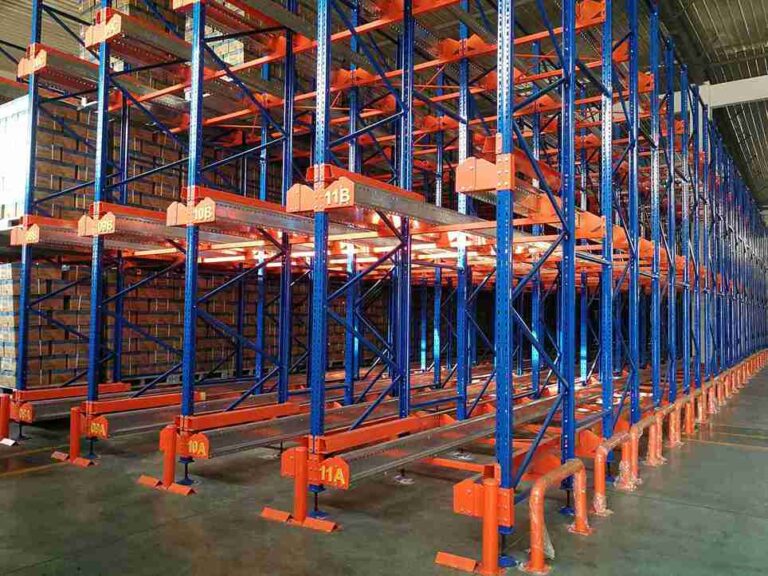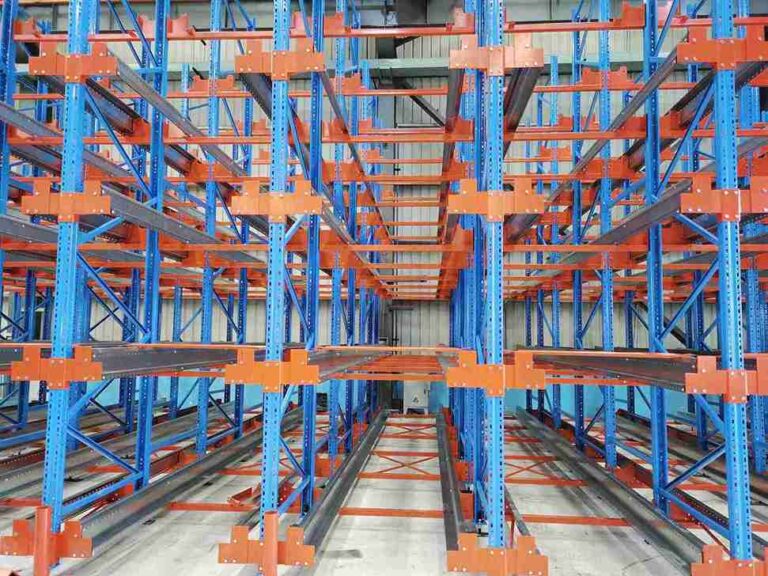📐 "First 50 Enterprise Queries Get Custom 3D Warehouse Design" Plan

In an era where warehouse space is at a premium and labor costs continue to rise, radio shuttle racking has emerged as the definitive solution for businesses seeking high-density storage, operational efficiency, and rapid return on investment (ROI). Unlike conventional pallet racking systems, radio shuttle racking leverages automated shuttle technology to optimize storage capacity, minimize manual handling, and streamline inventory management—making it indispensable for modern logistics operations.
This in-depth guide explores every facet of radio shuttle racking, from its mechanics and advantages to real-world applications, cost-benefit analysis, and integration with other automation technologies. Whether managing a cold storage facility, a high-volume distribution center, or an e-commerce fulfillment warehouse, this system offers a scalable, cost-effective solution that outperforms traditional storage methods.

1. Understanding Radio Shuttle Racking: The Future of High-Density Storage
1.1 How Radio Shuttle Racking Works
At its core, radio shuttle racking operates using motorized shuttle carts that travel along rails within deep storage lanes. These shuttles automatically transport pallets to designated locations, eliminating the need for forklifts to enter the racking structure. The system can be configured for:
-
Last-In, First-Out (LIFO) – Ideal for uniform SKUs with long-term storage.
-
First-In, First-Out (FIFO) – Essential for perishable goods in cold storage environments.
1.2 Key Components of a Radio Shuttle System
A fully functional radio shuttle racking setup consists of:
-
Shuttle Carts – Battery-powered, remotely controlled devices that move pallets.
-
Rails & Guide Systems – Ensure smooth and precise shuttle movement.
-
Control Software – Integrates with Warehouse Management Systems (WMS) for real-time tracking.
-
Loading/Unloading Stations – Where forklifts or AGVs interface with the system.
1.3 Comparing Radio Shuttle Racking to Traditional Systems
Unlike selective pallet racking, which requires wide aisles for forklift access, radio shuttle racking maximizes space by utilizing deep-lane storage. This design allows warehouses to:
-
Store up to 80% more pallets in the same footprint.
-
Reduce forklift traffic, lowering accident risks and product damage.
-
Speed up load retrieval through automation.
2. Why Radio Shuttle Racking is the Smart Choice for Modern Warehouses
2.1 Unmatched Storage Density & Space Optimization
One of the biggest challenges in warehousing is maximizing storage without expanding facility size. Radio shuttle racking solves this by:
-
Eliminating unnecessary aisles, allowing deeper storage lanes.
-
Storing more pallets per square meter than conventional systems.
-
Adapting to varying pallet sizes with adjustable configurations.
2.2 Faster Throughput & Reduced Labor Dependency
Labor shortages and rising wages make automation a necessity. Radio shuttle racking enhances efficiency by:
-
Automating pallet movement, reducing reliance on manual forklift operators.
-
Accelerating loading/unloading cycles, especially in high-turnover warehouses.
-
Minimizing human error, ensuring accurate inventory placement.
2.3 Enhanced Safety & Lower Operational Risks
Warehouse accidents often stem from forklift collisions and improper handling. Radio shuttle racking mitigates these risks by:
-
Restricting forklift entry into storage lanes.
-
Reducing pallet damage with controlled shuttle movements.
-
Improving workplace safety by minimizing manual labor in high-traffic zones.
3. Industries That Benefit Most from Radio Shuttle Racking
3.1 Cold Storage & Food Logistics
Perishable goods require FIFO inventory management to prevent spoilage. Radio shuttle racking excels in cold storage by:
-
Maintaining consistent temperatures in deep-lane setups.
-
Reducing energy costs by minimizing door openings (vs. traditional racking).
-
Ensuring compliance with food safety regulations.
3.2 Manufacturing & Bulk Material Handling
Factories storing raw materials or finished goods benefit from:
-
High-density storage for bulky, uniform SKUs.
-
Automated stock rotation, reducing manual labor.
-
Seamless integration with production line workflows.
3.3 E-Commerce & Third-Party Logistics (3PL) Providers
Fast-moving consumer goods (FMCG) and e-commerce fulfillment centers leverage radio shuttle racking for:
-
Faster order picking with automated retrieval.
-
Scalable storage solutions during peak seasons.
-
Reduced operational costs compared to manual systems.
4. Calculating ROI: How Radio Shuttle Racking Pays for Itself
4.1 Upfront Investment vs. Long-Term Savings
While radio shuttle racking requires a higher initial investment than traditional racking, the ROI is compelling:
-
Labor Cost Reduction – Fewer forklift operators needed.
-
Space Savings – More pallet positions without facility expansion.
-
Energy Efficiency – Lower HVAC costs in climate-controlled warehouses.
4.2 Real-World Case Study: 40% More Storage, 30% Lower Costs
A leading European logistics provider implemented radio shuttle racking and achieved:
-
40% increase in pallet storage capacity.
-
30% reduction in labor expenses within 18 months.
-
15% faster order fulfillment due to automated retrieval.
5. Choosing the Right Radio Shuttle System for Your Needs
5.1 Semi-Automated vs. Fully Automated Systems
-
Semi-Automated – Lower initial cost, requires some manual shuttle operation.
-
Fully Automated – Higher efficiency, integrates with WMS/ERP systems for hands-off operation.
5.2 Customization Options for Different Warehouse Requirements
-
LIFO vs. FIFO configurations – Depending on inventory turnover.
-
Heavy-duty vs. standard load capacities – For varying pallet weights.
-
Modular expandability – To scale with business growth.
6. Integrating Radio Shuttle Racking with Other Automation Technologies
6.1 AGVs & Autonomous Forklifts
-
Automated Guided Vehicles (AGVs) can transport pallets to/from shuttle systems.
-
Autonomous Mobile Robots (AMRs) enhance flexibility in dynamic warehouses.
6.2 Warehouse Management System (WMS) Compatibility
-
Real-time inventory tracking ensures accurate stock levels.
-
Automated replenishment triggers optimize stock rotation.
7. Maintenance & Longevity of Radio Shuttle Racking Systems
7.1 Ensuring Peak Performance with Proper Maintenance
-
Regular rail cleaning prevents debris buildup.
-
Battery management (lithium-ion vs. lead-acid options).
-
Software updates for optimal system performance.
7.2 Expected Lifespan & Durability
-
10-15 years with proper upkeep.
-
Minimal downtime due to robust shuttle design.
8. The Future of Radio Shuttle Racking & Smart Warehousing
8.1 AI & Machine Learning for Predictive Storage Optimization
-
Demand forecasting to pre-position high-turnover SKUs.
-
Automated lane balancing to prevent congestion.
8.2 Sustainable Warehousing with Energy-Efficient Solutions
-
Solar-powered shuttles in development.
-
Regenerative braking systems to extend battery life.
9. Why Leading Warehouses Trust Our Radio Shuttle Racking Solutions
-
20+ years of industry expertise in high-density storage.
-
Custom-engineered designs tailored to your facility.
-
End-to-end support, from installation to maintenance.
10. Conclusion: Transform Your Warehouse with Radio Shuttle Racking
Radio shuttle racking is not just a storage solution—it’s a strategic investment that enhances efficiency, reduces costs, and future-proofs warehouse operations. Whether optimizing cold storage, manufacturing, or e-commerce fulfillment, this system delivers measurable ROI while adapting to evolving industry demands.
Ready to upgrade your storage infrastructure? Contact our experts today for a free consultation!
FAQs
Q1: Can radio shuttle racking be retrofitted into an existing warehouse?
Yes, most facilities can be adapted with a structural assessment to ensure load-bearing compatibility.
Q2: How does radio shuttle racking compare to AS/RS (Automated Storage & Retrieval Systems)?
While AS/RS excels in high-speed, small-item retrieval, radio shuttle racking is more cost-effective for deep-lane pallet storage.
Q3: What’s the maximum weight capacity for shuttle systems?
Standard systems handle 1,000–1,500 kg per pallet, with heavy-duty options for 3,000+ kg loads.
Q4: Is radio shuttle racking suitable for hazardous environments?
Yes, explosion-proof models are available for chemical and pharmaceutical storage.
Q5: What’s the typical lead time for installation?
Approximately 8–12 weeks, depending on customization and facility prep.
Welcome to contact us, if you need warehouse rack CAD drawings. We can provide you with warehouse rack planning and design for free. Our email address is: jili@geelyracks.com




